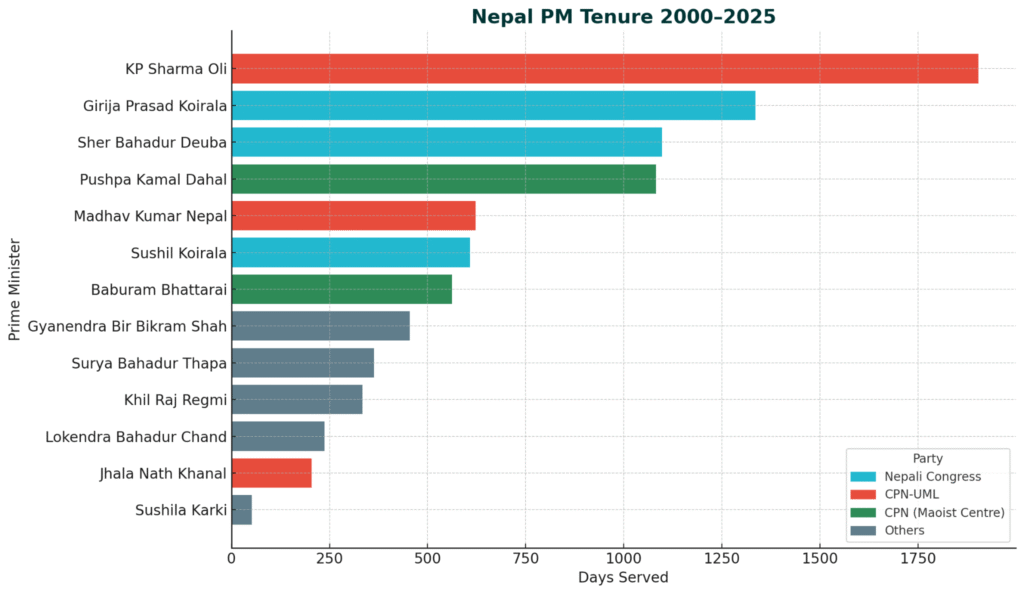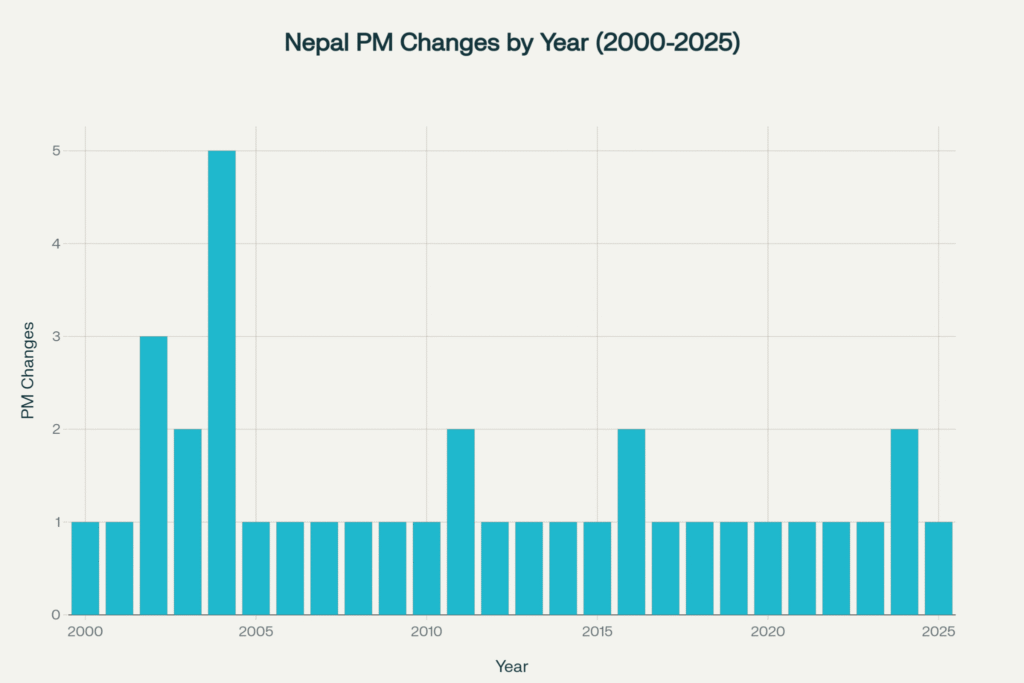Comprehensive Analysis with Data & Reports
Nepal has emerged as one of the world’s most politically unstable nations, earning the distinction of being a global leader in government turnover. Since 2000, Nepal has had 24 prime ministers in just 25 years—an average of one new government per year. This extraordinary political volatility reflects a combination of structural institutional failures, party system fragmentation, constitutional ambiguities, corruption, socioeconomic grievances, and geopolitical interference.
The Scale of Political Instability

Prime Ministers of Nepal: Tenure Length (2000-2025), Showing the number of days each PM served
Between 2000 and 2005, Nepal experienced what scholars describe as a “period of acute instability,” with government changes occurring so frequently that functional governance became nearly impossible. During the 2002-2004 period alone, the country cycled through multiple prime ministers in rapid succession due to constitutional ambiguities and floor-crossing by members of parliament.
The most recent crisis emerged dramatically in September 2025 when KP Sharma Oli’s government collapsed following massive anti-corruption protests. What began as youth-driven demonstrations against the lavish lifestyle of government leaders children evolved into a broader movement of demanding accountability and an end to political corruption. The resulting violence claimed at least 74 lives, with federal parliament buildings set ablaze and political elites forced to flee. This led to Oli’s resignation and the appointment of Sushila Karki, Nepal’s first female Prime Minister, as an interim leader through an unprecedented popular selection process.
Key Data on Prime Minister Tenures

Prime Minister Changes Per Year (2000-2025) – Showing the frequency of government transitions annually in Nepal
The data reveals dramatic disparities in tenure length. The average tenure across the period stands at approximately 522 days (17.4 months)—far below the typical 5-year mandate expected in democratic systems.
Some prime ministers served multiple terms: Girija Prasad Koirala (5 times), Sher Bahadur Deuba (5 times), Pushpa Kamal Dahal “Prachanda” (3 times), Lokendra Bahadur Chand (3 times), Surya Bahadur Thapa (3 times), and KP Sharma Oli (3 times). This cyclical pattern of leadership reflecting the same faces in different coalitions has led scholars to describe Nepali politics as resembling “musical chairs” or a “leg-pulling game.”
Internal Structural Causes:
Fragmented Party System and Weak Coalition Governments
Nepal’s core problem stems from its highly fragmented political party landscape. Following the 2021 general elections, no single party secured an outright parliamentary majority, necessitating coalition governments composed of ideologically disparate parties. The mixed electoral system—combining 60% first-past-the-post (FPTP) and 40% proportional representation—was intended to increase inclusivity but instead created numerous smaller parties with narrow, regional interests that prioritize personal power over national stability.
These coalitions prove inherently unstable because parties possess “fundamentally competing interests and ideologies” with no shared vision for national development. When parties with opposing ideological positions govern together, consensus on critical policy issues becomes nearly impossible, leading to rapid government collapse.
Intra-Party Conflicts and Power Struggles
Personality-driven politics and factional divisions within parties represent a major driver of instability. Research from 2024-2025 documents that “factionalism and rifts among political parties in Nepal, including those that comprise the ruling coalition, have historically been common.” Within the same party, competing factions battle for leadership positions and control over resources, undermining unified party governance.
The absence of robust internal party democracy exacerbates this problem. Decisions emerge from a narrow cadre of top leaders with minimal consultation or consensus-building at lower party levels, creating bitterness and enabling defections. When intra-party conflicts erupt, they frequently result in party splits or the defection of key members, destabilizing government coalitions.
Constitutional Ambiguities and Legal Loopholes
Nepal’s 2015 Constitution contains significant ambiguities regarding government formation and dissolution, providing political actors with ample opportunities for maneuvering and manipulation. The constitution fails to specify clear criteria for determining parliamentary majorities required for government formation or mechanisms for orderly government transitions. This ambiguity has been exploited by politicians seeking tactical advantage.
Additionally, weak provisions against floor-crossing and defections enable parliamentarians to abandon their parties mid-term, undermining coalition stability. Although constitutional provisions technically make an MP’s seat vacant upon party defection, this mechanism has historically remained unenforced due to weak institutional capacity.
Corruption and Lack of Accountability
Widespread corruption combined with systematic impunity has eroded public confidence in political institutions and destabilized governments. Academic research (2024) documents that “corruption is well-rooted in many areas and has led to a loss of faith in government institutions and determined political instability.”
The absence of effective oversight mechanisms and anti-corruption enforcement creates a culture where political elites engage in bribery, patronage, and resource capture without consequence. This corruption-driven factionalism further fragments political parties as individuals and groups compete for illicit access to state resources.
The September 2025 Gen Z protests specifically targeted what protesters labeled “nepo kids”—children of political elites enjoying privileged lifestyles while ordinary Nepalis struggled to find employment. The movement’s success in forcing PM Oli’s resignation reflects accumulated public rage over pervasive corruption that successive governments failed to address.
Socioeconomic Grievances and Public Discontent
Nepal faces persistent challenges of poverty, unemployment, and income inequality, generating widespread public frustration with political systems unable to address these issues. The COVID-19 pandemic significantly worsened economic conditions, reducing remittance flows, tourism revenue, and foreign aid—the three pillars of Nepal’s economy—creating additional economic stress and political pressure.
Research from 2024 notes that “the government’s inability to effectively address pressing socio-economic challenges, such as poverty, unemployment, and inequality, further fueled public frustration, creating a fertile ground for political instability.” When successive governments fail to deliver on economic development promises, public trust deteriorates and citizens increasingly mobilize for political change.
External Structural Causes
India-China Geopolitical Rivalry
Nepal’s landlocked position between two Asian superpowers creates constant geopolitical pressure affecting domestic politics. India maintains traditional strategic and economic ties with Nepal, hosting the largest Nepali diaspora under an open labor migration policy, while China advances its Belt and Road Initiative (BRI) infrastructure projects throughout Nepal.
Research documents that the geostrategic location of landlocked Nepal between the two Asian giants has made it a center of competition for regional influence. Through economic, political, and cultural instruments, both countries have tried to consolidate their relations with Nepal. This rivalry creates political polarization within Nepal, with some political factions aligned more closely with India and others with China.
The impacts are concrete: “The impact of India and China on Nepali politics has regularly caused fractions in the Nepali government and political parties.” Political alignment disputes—particularly around foreign policy decisions, infrastructure development choices, and security matters—contribute to coalition breakdown.
International Donor Conditionalities and Financial Constraints
Nepal’s economic dependence on foreign aid and loans creates additional destabilizing pressures. International organizations (World Bank, Asian Development Bank) and donor countries impose specific conditions on financial assistance, often requiring economic liberalization, privatization, good governance reforms, and human rights protections.
While well-intentioned, these conditions sometimes conflict with domestic political interests and the preferences of ruling coalitions, creating internal tensions and policy disputes that destabilize governments. 2024 research suggests that such conditionalities will likely create internal tensions within the Nepali state and its political parties. This invites contention, policy inertia, and even the fall of incredibly fragile coalition governments where consensus is hard to find.
Global Economic Vulnerability
Nepal’s overdependence on remittances (from migrant workers), foreign tourism, and development aid—contributing approximately 23-25% of GDP, tourism, and significant portions of foreign exchange—creates extreme vulnerability to global economic shocks. Global economic recessions, reduced remittance flows, tourism declines, and changes in international commodity prices directly impact Nepal’s economy and political stability.
The 2025 Turning Point: Gen Z Protests and Democratic Renewal
The September 2025 events mark a potential watershed moment in Nepali political history. When PM KP Oli’s government attempted to restrict social media access on August 26, 2025, massive youth-led protests erupted that evolved beyond the initial trigger to encompass broader anti-corruption demands. The government’s violent suppression of protests resulted in at least 74 deaths before Oli’s resignation on September 9.
The appointment of Sushila Karki as interim PM represented an unprecedented democratic moment, with Gen Z protesters using online voting (Discord polls) to select their preferred caretaker leadership. Over 7,713 protesters participated, voting 49.7% for Karki over alternative candidates. Her selection broke the traditional pattern of elite-driven government formation, with parliament dissolved and new elections scheduled for March 5, 2026.
As one source notes, Karki’s appointment “signifies a moment where a desperate public cry for personal integrity triumphed over the entrenched machinery of party politics.” Her background as Nepal’s first female Chief Justice (2016-2017) and reputation for uncompromising anti-corruption stance position her as a figure outside the traditional political establishment.
Several government changes in Nepal resulted from a complex interplay of domestic and external factors. This political instability stems from a fragmented party system, weak coalitions, constitutional ambiguities, corruption, dwindling socioeconomic conditions for citizens and rising geopolitical challenges.
